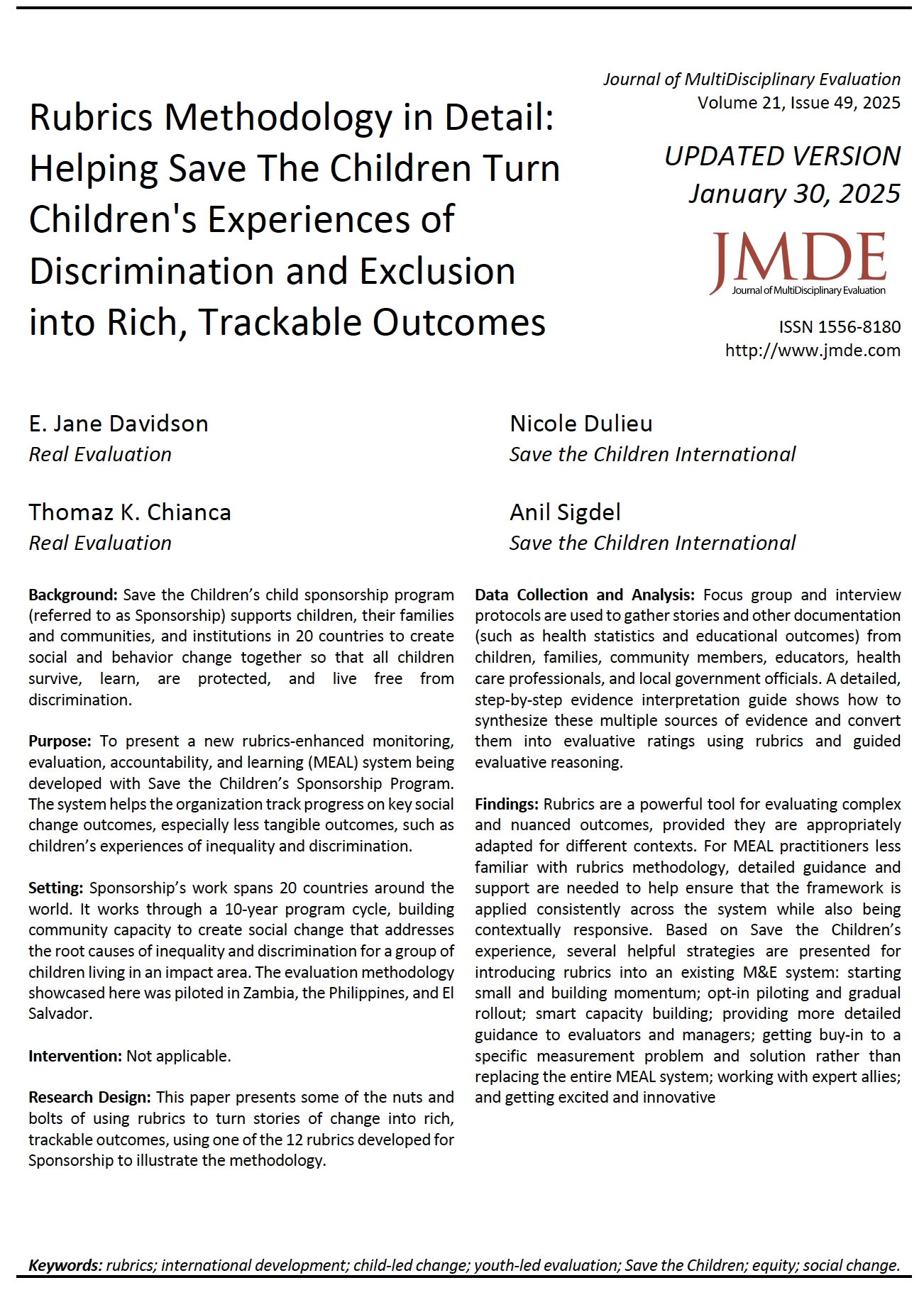Rubrics Methodology in Detail: Helping Save The Children Turn Children's Experiences of Discrimination and Exclusion into Rich, Trackable Outcomes
Main Article Content
Abstract
Background: Save the Children’s child sponsorship program (referred to as Sponsorship) supports children, their families and communities, and institutions in 20 countries to create social and behavior change together so that all children survive, learn, are protected, and live free from discrimination.
Purpose: To present a new rubrics-enhanced monitoring, evaluation, accountability, and learning (MEAL) system being developed with Save the Children’s Sponsorship Program. The system helps the organization track progress on key social change outcomes, especially less tangible outcomes, such as children’s experiences of inequality and discrimination.
Setting: Sponsorship’s work spans 20 countries around the world. It works through a 10-year program cycle, building community capacity to create social change that addresses the root causes of inequality and discrimination for a group of
children living in an impact area. The evaluation methodology showcased here was piloted in Zambia, the Philippines, and El Salvador.
Intervention: Not applicable.
Research Design: This paper presents some of the nuts and bolts of using rubrics to turn stories of change into rich, trackable outcomes, using one of the 12 rubrics developed for Sponsorship to illustrate the methodology.
Data Collection and Analysis: Focus group and interview protocols are used to gather stories and other documentation (such as health statistics and educational outcomes) from children, families, community members, educators, health care professionals, and local government officials. A detailed, step-by-step evidence interpretation guide shows how to synthesize these multiple sources of evidence and convert them into evaluative ratings using rubrics and guided evaluative reasoning.
Findings: Rubrics are a powerful tool for evaluating complex and nuanced outcomes, provided they are appropriately adapted for different contexts. For MEAL practitioners less familiar with rubrics methodology, detailed guidance and support are needed to help ensure that the framework is applied consistently across the system while also being contextually responsive. Based on Save the Children’s experience, several helpful strategies are presented for introducing rubrics into an existing M&E system: starting small and building momentum; opt-in piloting and gradual rollout; smart capacity building; providing more detailed guidance to evaluators and managers; getting buy-in to a specific measurement problem and solution rather than replacing the entire MEAL system; working with expert allies; and getting excited and innovative.
Downloads
Article Details

This work is licensed under a Creative Commons Attribution-NonCommercial 4.0 International License.
Copyright and Permissions
Authors retain full copyright for articles published in JMDE. JMDE publishes under a Creative Commons Attribution-NonCommercial 4.0 International License (CC BY - NC 4.0). Users are allowed to copy, distribute, and transmit the work in any medium or format for noncommercial purposes, provided that the original authors and source are credited accurately and appropriately. Only the original authors may distribute the article for commercial or compensatory purposes. To view a copy of this license, visit creativecommons.org
References
Chianca, T. K. & Davidson, E. J. (2020). Retrospective impact evaluation: Save the Children’s Sponsorship programming in Woliso impact area, Ethiopia (2002-2010). Save the Children Child Rights Resource Center. https://resourcecentre.savethechildren.net/document/retrospective-impact-evaluation-save-childrens-sponsorship-programming-woliso-impact-area/
Chianca, T. K., Davidson, E. J., Dulieu, N. & Sigdel, A. (2024). Rubrics 11: A toolkit to address child discrimination and exclusion. Save the Children Child Rights Resource Center. https://resourcecentre.savethechildren.net/document/rubrics-11-a-toolkit-to-address-child-discrimination-and-exclusion/
Davidson (n.d.). What are rubrics? Real Evaluation LLC. https://realevaluation.com/what-are-rubrics/
Davidson, E. J. (2024, forthcoming). Evaluation methodology basics: The nuts and bolts of sound evaluation (2nd ed.). Thousand Oaks, CA: Sage.
Falk, E. (2021, June 27). Op-Ed: Why storytelling is an important tool for social change. Los Angeles Times. https://www.latimes.com/opinion/story/2021-06-27/stories-brain-science-memory-social-change
Salm, M. (n.d.). Personal stories. Better Evaluation, Evaluation Methods. https://www.betterevaluation.org/methods-approaches/methods/personal-stories
Save the Children (n.d.-a). Where we work. https://www.savethechildren.net/where-we-work#
Save the Children (n.d.-b). Sponsorship programs. Save the Children Child Rights Resource Center. https://resourcecentre.savethechildren.net/collection/sponsorship-programs/
Scriven, M. (1991). Evaluation thesaurus (4th ed.). Thousand Oaks, CA: Sage.
Toll, E. (n.d.). Greetings and customs around the world. Diversity Insights. DiversityResources. https://www.diversityresources.com/greeting-customs-around-the-world/
United Nations (1989). Convention on the Rights of the Child. United Nations Human Rights Office of the High Commissioner. https://www.ohchr.org/en/instruments-mechanisms/instruments/convention-rights-child

